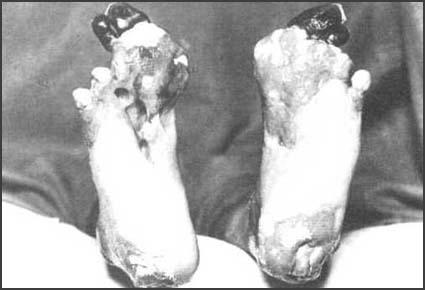Trench foot was a serious medical condition affecting soldiers in the trenches during WWI. It was caused by prolonged exposure to cold, damp, and unsanitary conditions. This page investigates the causes, symptoms, impact, and management of trench foot, as well as the efforts made to prevent and treat this debilitating condition.
Causes of Trench Foot
Trench foot resulted from prolonged exposure to cold and wet conditions, particularly when soldiers' feet were constantly submerged in muddy water. The trenches often filled with water, and the soldiers' boots were ineffective at keeping their feet dry. The combination of cold temperatures and dampness led to poor circulation and swelling, which were key factors in the development of trench foot.
The condition was worsened by the lack of proper footwear and the inability to change wet socks and boots regularly. The unsanitary conditions in the trenches further contributed to the severity of the condition.
Symptoms and Impact
The symptoms of trench foot included numbness, swelling, and a tingling sensation in the feet. In more severe cases, the skin would become red and inflamed, eventually leading to blisters, and ulcers. The condition could lead to serious complications, including the need for amputation in extreme cases.
Trench foot had a significant impact on soldiers' health and ability to perform their duties. The debilitating nature of the condition meant that affected soldiers were often unable to continue fighting, which impacted their effectiveness and overall morale.

Management and Prevention
Managing trench foot involved several measures aimed at alleviating symptoms and preventing the condition from worsening. Treatment typically included warming the affected feet, keeping them dry, and using antiseptic treatments to prevent infection. Soldiers were also encouraged to change their socks and boots regularly and to use foot powder when available.
Preventive measures included improving the drainage in trenches, issuing better-quality boots, and ensuring that soldiers had access to dry socks and other necessary supplies. Despite these efforts, trench foot remained a significant problem throughout the war, highlighting the challenges of maintaining health in such harsh conditions.
Conclusion
Trench foot was a debilitating condition that underscored the harsh realities of trench warfare. The impact of prolonged exposure to cold and wet conditions on soldiers' health was profound, affecting their ability to fight and endure the trenches. Understanding the causes, symptoms, and management of trench foot provides insight into the broader challenges faced by soldiers during World War I and the efforts made to mitigate such conditions.
